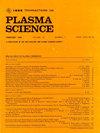Study on the Drawn Vacuum Arc Characteristics of the 126 kV Axial Magnetic Field Contacts
IF 1.5
4区 物理与天体物理
Q3 PHYSICS, FLUIDS & PLASMAS
引用次数: 0
Abstract
During the current interruption process, the vacuum arc evolution characteristics are crucial in determining whether a vacuum circuit breaker can interrupt the current successfully. In order to analyze the expansion characteristics of cathode spots (CSs) on the 126 kV axial magnetic field (AMF) contacts, the drawn vacuum arc experiments were conducted. To observe more characteristics of the drawn vacuum arc, two high-speed cameras were used simultaneously to capture the dynamics of both the vacuum arc and CSs. The experimental results indicated that the vacuum arc column could not expand sufficiently to cover the entire contact surface. Additionally, multiple types of vacuum arc column modes occurred in the experiments, and the number of ignition positions also affected both the appearance of vacuum arc and the diffusion process of CSs. Moreover, the magnetic field distribution under different vacuum arc column modes was simulated. In the contact surface near the contact edge, the AMF components are smaller than the transverse magnetic field (TMF) components and these lead a rapid radial expansion of CSs. Furthermore, significant deflection occurs for CSs located in central area on both cup-type AMF contact and coil-type contacts. However, the CSs of these two types of contacts show different deflection directions. When the total arc area remains constant but the number of arc columns increases, the TMF components decreases and radial velocity of CSs also decrease. The simulation results also indicated that the variation in the number of arc columns has a relatively small impact on the distribution of the AMF component.126kv轴向磁场触点抽真空电弧特性研究
在断流过程中,真空电弧演化特性是决定真空断路器能否成功断流的关键。为了分析126 kV轴向磁场(AMF)触点上阴极斑点(CSs)的膨胀特性,进行了抽真空电弧实验。为了观察绘制的真空弧的更多特征,同时使用两台高速摄像机捕捉真空弧和CSs的动态。实验结果表明,真空弧柱不能充分膨胀以覆盖整个接触面。此外,实验中出现了多种类型的真空弧柱模式,点火位置的多少也影响了真空弧的出现和CSs的扩散过程。此外,还模拟了不同真空弧柱模式下的磁场分布。在接近接触边缘的接触面上,AMF分量小于横向磁场分量,这导致了CSs的快速径向膨胀。此外,在杯型和线圈型触点上,位于中心区域的CSs都发生了显著的挠度。然而,这两种触点的接触网呈现出不同的偏转方向。当电弧总面积不变,但弧柱数增加时,TMF分量减小,CSs径向速度也减小。模拟结果还表明,弧柱数的变化对AMF分量分布的影响相对较小。
本文章由计算机程序翻译,如有差异,请以英文原文为准。
求助全文
约1分钟内获得全文
求助全文
来源期刊

IEEE Transactions on Plasma Science
物理-物理:流体与等离子体
CiteScore
3.00
自引率
20.00%
发文量
538
审稿时长
3.8 months
期刊介绍:
The scope covers all aspects of the theory and application of plasma science. It includes the following areas: magnetohydrodynamics; thermionics and plasma diodes; basic plasma phenomena; gaseous electronics; microwave/plasma interaction; electron, ion, and plasma sources; space plasmas; intense electron and ion beams; laser-plasma interactions; plasma diagnostics; plasma chemistry and processing; solid-state plasmas; plasma heating; plasma for controlled fusion research; high energy density plasmas; industrial/commercial applications of plasma physics; plasma waves and instabilities; and high power microwave and submillimeter wave generation.
 求助内容:
求助内容: 应助结果提醒方式:
应助结果提醒方式:


